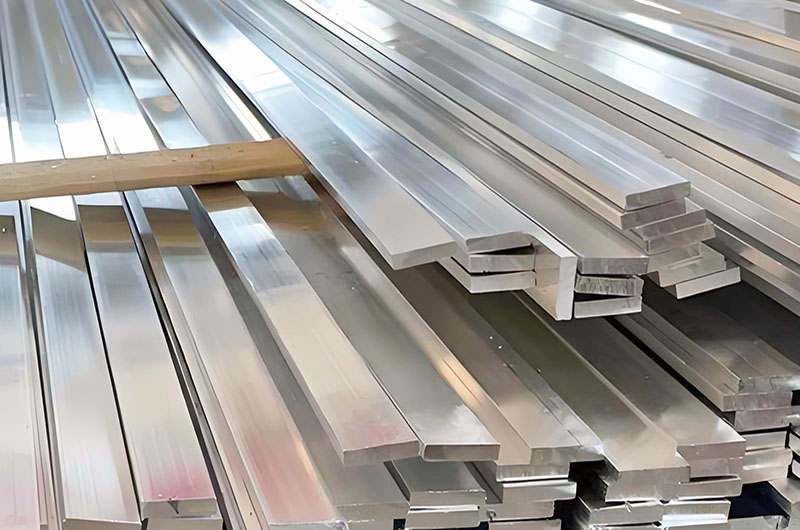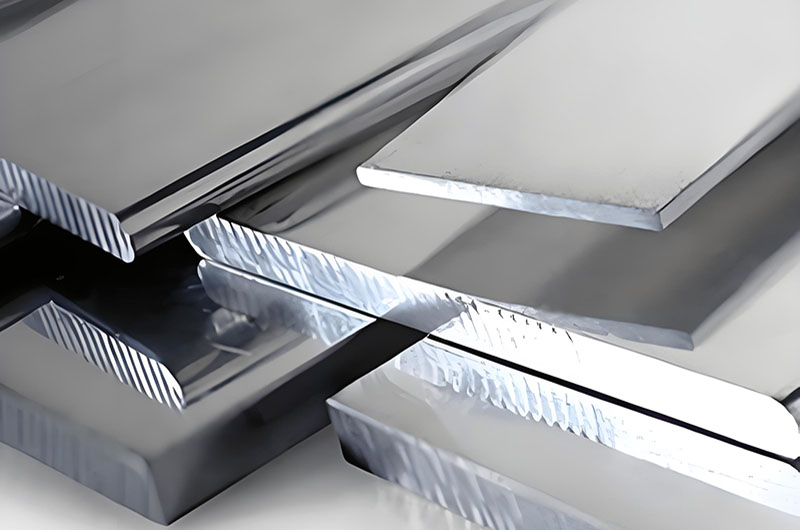1350 aluminum busbar is a conductive busbar made of industrial pure aluminum with a purity of ≥99.5%. It has high conductivity, lightweight properties, and cost advantages, making it widely used in power systems, new energy equipment, and industrial distribution fields. The 1350 aluminum busbar can be enhanced with tin plating or anodizing to improve corrosion resistance. However, for the same current-carrying capacity, a larger cross-section is required compared to copper busbars. It is also necessary to consider thermal expansion compensation and anti-corrosion design for copper-aluminum connections. It serves as an economical and efficient solution for medium and low-voltage high-current scenarios.

1350 aluminum is a commercially high-purity aluminum alloy widely used in electrical applications. Compared to the International Annealed Copper Standard (IACS), it can achieve approximately 61% conductivity. Its lightweight nature, combined with good corrosion resistance and ease of manufacturing, makes it an attractive choice for busbars, electrical conductors, and transformer components.
1350 aluminum busbars are a versatile and cost-effective choice for electrical distribution, balancing conductivity, weight, and cost. Proper design and maintenance mitigate challenges such as oxidation and thermal expansion, ensuring reliable performance in various applications.
HC 1350 EC-grade aluminum busbars comply with ASTM B317, ASTM B236, IEC 60105, ISO 209-1, 2, DIN EN 755-2, and DIN EN 755-5:2008-06 standards. The 1350 aluminum busbar features excellent conductivity, high strength, good corrosion resistance, and a lightweight design.
HC 1350 Power Busbar Specifications
| EC 1350 Aluminum Busbar Specifications | |
| Temper | O, H14, H16, H19 |
| Shape | Rectangular, round, or tubular profiles; rectangular is the most common for effective current distribution. |
| Surface Quality Requirements | Smooth surface, free of burrs, spots, and other defects; clean surface, free of dust, oil, and other impurities; uniform and dense oxide layer with good corrosion resistance. |
| Surface Treatment | Anodizing, electroplating, coating, etc. Common aluminum plating layers include silver, tin, and nickel. |
| Insulation Treatment | Insulating coatings: powder coating, epoxy resin coating, or insulating varnish coating. Insulating sleeves: PVC, heat shrink tubing, or silicone rubber. |
| Processing | Stamping, bending, drilling, tapping, polishing, etc. |
| Testing | Conductivity testing, temperature rise testing, bending testing, salt spray test (e.g., ASTM B117), etc. |
| Standards | ASTM B317: Standard specification for aluminum bus conductors. |
| IEC 60439: Low-voltage switchgear and controlgear assemblies. | |
1350 Aluminum Busbar Electrical Properties
| Electrical Properties | Description |
| Conductivity | The electrical conductivity of the 1350 aluminum busbar is 61.8% IACS (International Annealed Copper Standard), corresponding to a resistivity of approximately 2.65×10⁻⁸ Ω·m at 20°C. This means it has good conductivity, which effectively reduces energy loss in power transmission and distribution systems. As a result, 1350 aluminum busbars are commonly used in high-voltage and low-voltage switchgear, distribution panels, bus ducts, and transformer windings to ensure efficient current transmission. |
| Rated (Current Carrying Capacity) | The current carrying capacity of the 1350 aluminum busbar depends on its cross-sectional area, shape, and ambient temperature. Compared to copper busbars, aluminum has lower conductivity, requiring a larger size to compensate for this shortcoming. However, the 1350 aluminum busbar is lighter and has good corrosion resistance, making it an ideal choice for long-distance transmission and lightweight applications. |
1350 aluminum busbar Chemical Composition
| AW1350 | Silicon (max.) | Iron (max.) | Copper (max.) | Manganese (max.) | Chromium (max.) | Zinc (max.) | Boron (max.) | Gallium (max.) | Vanadium and Titanium Total (max.) | Other elements Each | Other elements Total | Aluminium |
| Composition (%) | 0.1 | 0.4 | 0.05 | 0.01 | 0.01 | 0.05 | 0.05 | 0.03 | 0.02 | 0.03 | 0.1 | >=99.50 |
1350 Aluminum Busbar Mechanical and Physical Properties
- Ductility: Annealed elongation is about 23%, easy to bend and process.
- Density: 2.7 g/cm³, only 30% of copper, with significant lightweight advantages.
- Tensile Strength: The strength of 1350 aluminum depends on its temper – for example, extruded busbars are usually produced in the –H11 temper, while sawed plates are typically in the –H112 temper. The typical ultimate tensile strength range is 60 to 95 N/mm².
- Density: Approximately 2.70 g/cm³.
- Bendability: 1350 aluminum alloy is relatively soft and can be easily manufactured (bent, stamped, or drilled) to meet specific installation requirements. The bending radius typically depends on thickness and temper, ensuring sufficient installation flexibility.
1350 Aluminum Busbar Temper Options
- H14: Medium hardness, belongs to strain-hardened tempers, achieved through cold rolling or drawing processes, suitable for applications requiring a balance of ductility and strength.
- H16/H19: Higher hardness, also strain-hardened tempers, achieved through cold rolling or drawing, suitable for applications requiring high mechanical strength, such as support structures in industrial distribution equipment.
- H112: Suitable for hot-rolled plates or sawed rolled plates, retaining some hot-working characteristics with high surface quality requirements.
- -F: Denotes "As-Fabricated" condition, not subjected to special heat treatment or cold working, typically used for cast busbars, suitable for low-cost, quick delivery general applications.
Performance Comparison of Different Tempers
| Temper | Tensile Strength Range (MPa) | Typical Application Scenarios |
| 1350 H14 | 110-145 | Distribution cabinets, transformer connection bars |
| 1350 H16/H19 | 145-180 | Support structures for high-current equipment |
| 1350 H112 | 60-95 | Hot-rolled plates or busbars requiring secondary surface processing |
| -F | 60-95 | Cast busbars or low-cost general applications |
Selection Recommendations
- Balance of conductivity and processability: H14/H16/H19 are suitable for scenarios requiring both conductivity (61.8% IACS) and strength, such as conductors inside new energy inverters.
- Thermal stability requirements: H112 hot-rolled plates are better suited for high-temperature environments (e.g., metallurgical equipment) due to lower residual processing stress.
Advantages of HC 1350 Aluminum Conductive Bus Bar
- Excellent conductivity: 1350 aluminum alloy has high electrical conductivity, close to pure aluminum.
- Cost-effectiveness: Material cost is lower than copper, priced at about 1/3 of copper busbars, and its lightweight nature reduces support structure costs.
- Lightweight: ~1/3 the density of copper, reducing structural support requirements.
- Corrosion resistance: Natural oxide layer resists environmental degradation.
- Reliability: Good conductivity and corrosion resistance enhance the reliability of 1350 conductive aluminum busbars in power transmission.
- Long service life: Corrosion resistance and reliability give 1350 conductive aluminum busbars a longer lifespan, reducing replacement costs.
- Easy to process: Can be cut and drilled without special tools.

1350 Aluminum Busbar Processing
Manufacturing Process
Forming: Produced by hot extrusion or cold rolling into rectangular, round, or other cross-sectional shapes, with common thicknesses ranging from 10-120mm and widths from 50-600mm.
Surface Treatment
- Tin/Silver Plating: Enhances oxidation resistance and reduces contact resistance.
- Anodizing: Improves corrosion resistance, suitable for humid environments.
- Processing: Can be punched, milled, and bent (minimum bending radius depends on thickness), with precautions to avoid excessive cold work hardening.
1350 aluminum busbars are manufactured using various processes to suit different applications:
- Extrusion: Typically produced in –H11 temper to balance electrical conductivity and mechanical strength.
- Sawed Plates: Typically produced in –H112 temper, maintaining good electrical performance while having slightly higher strength.
- Casting: Used in –F temper when complex shapes are required.
The degree of work applied during manufacturing directly affects tensile strength. This process effect allows customization of final mechanical properties by adjusting processing parameters.
1350 Aluminum Busbar Dimensions and Customization
1350 aluminum busbars come in various dimensions:
- Thickness: Ranges from as thin as 0.15mm to about 40mm.
- Width: Typically available in 10mm increments from 10mm to 200mm.
- Length: Customizable, commonly used in lengths up to 6 meters or longer.
These versatile dimensions enable manufacturers to meet specific design requirements in electrical distribution systems, ensuring optimal performance and minimal energy loss.
1350 Aluminum Conductive Bus Bar Common Market Specifications
Cross-sectional shapes: Rectangular (dominant), round, custom profiles.
Typical Sizes:
- Small: 30mm×4mm, 40mm×5mm
- Medium: 80mm×10mm, 100mm×12.5mm
- Large: 120mm×15mm, 150mm×20mm
1350 Aluminum Busbar Applications
- Busbars and Electrical Conductors: Used in switchgear, distribution boards, and power transformers.
- Cable Wrapping: Where weight reduction is critical.
- Heat Exchangers and Radiator Tubes: Due to its high thermal and electrical conductivity.
- Other Electrical Equipment: Such as transformer windings and generator panels.
- Power Distribution in Switchgear, Transformers, Substations, and Bus Tubes.
- Industrial Equipment: Internal conductors for inverters, welding machines, and large motors.
- New Energy: Conductive busbars in photovoltaic inverters, energy storage systems, and electric vehicle charging stations.
- Transportation: High-voltage power distribution systems in rail transit vehicles.
Preferred for cost-sensitive or weight-critical installations (e.g., renewable energy systems, industrial plants).
Compared to copper, its cost-effectiveness makes it a popular choice for both high-current and critical applications.
1350 Aluminum Bus Bar Alternative Material Comparison
| Comparison Item | Description |
| 1350 Aluminum Busbar vs. Copper Busbar | The conductivity per unit weight of 1350 aluminum busbars is superior to copper, but its conductivity per unit volume is lower. Since aluminum's density is about one-third of copper's, 1350 aluminum busbars can provide a longer conductive path for the same weight, making them advantageous in lightweight applications. However, due to its lower conductivity per unit volume, 1350 aluminum busbars generally require a larger cross-sectional area to match the same current-carrying capacity as copper. Therefore, in power engineering, engineers must balance size, weight, and cost to determine the appropriate busbar material. |
| 1350 Aluminum Busbar vs. 6061 Aluminum Alloy Busbar | The electrical conductivity of 1350 aluminum busbars is superior to 6061 aluminum alloy, but its mechanical strength is lower. Since 6061 aluminum alloy contains magnesium and silicon, it has higher strength and better mechanical performance, making it suitable for applications requiring high mechanical loads. However, 6061 has lower conductivity than 1350, so for applications requiring high electrical conductivity, such as transformer windings and distribution busbars, 1350 aluminum busbars are the preferred choice. In power system design, it is essential to decide whether to prioritize conductivity or mechanical strength based on specific requirements. |
Limitations of 1350 Aluminum Conductive Bus Bar
- Current Carrying Capacity: About 78% of copper for the same cross-sectional area, requiring a larger cross-section to match the same current.
- Thermal Expansion: Higher coefficient of linear expansion (23.1×10⁻⁶/℃), requiring expansion joints for long busbars.
Installation and Maintenance Considerations
- Electrochemical Corrosion: Use bimetallic connectors or plating when interfacing with different metals (e.g., copper).
- Creep Resistance: Apply appropriate torque to joints and use Belleville washers to maintain pressure over time.
- Thermal Management: Ensure adequate spacing and ventilation to handle heat dissipation.


